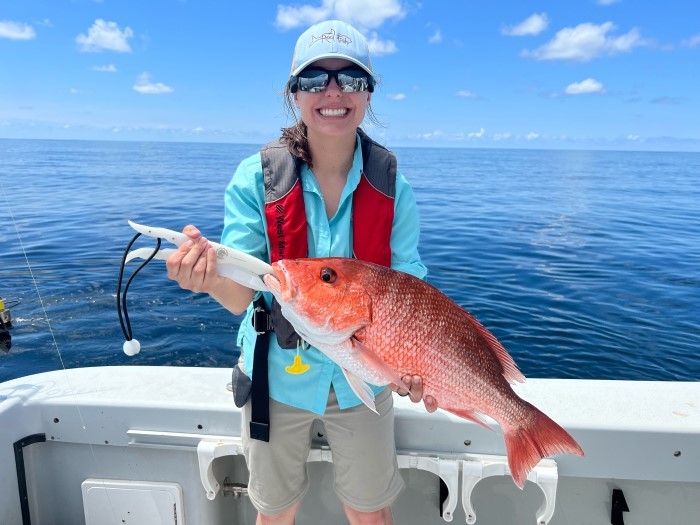
Photo Courtesy of CCA Florida
Proposed bottom closure highlights need for regulatory reform
Several years ago, red snapper anglers in the Gulf of Mexico were facing an almost inexplicable management dilemma. After several decades of conservation challenges and political gyrations, the red snapper fishery was finally rebounding at a rate far beyond expectations. In the space of just a few short years, red snapper became so abundant that it was difficult to catch anything else offshore.
Anglers soon found themselves in a “recovery trap,” which meant that since the fish were so easy to catch, NOAA Fisheries calculated to show that the entire recreational quota was being caught in a matter of days. The fishery was obviously booming, but the recreational season was getting shorter. Eventually it was set at a mere three days, and the wheels came off. Questions arose about every aspect of the fishery – was the recreational harvest data accurate? How is it possible to overfish a stock that continues to grow? Should a stock be considered recovered based on a calculation or based on what is happening in the water? And where did all these fish come from??
Flash forward past an incredible amount of debate and the Gulf states eventually were given authority to manage the private recreational sector using their own data collection systems, which are universally acknowledged to be much more robust than the federal data system. Perhaps more importantly, Congress authorized $10 million for an unprecedented, independent assessment of Gulf red snapper which eventually showed that the actual population was, conservatively, at least three times larger than previously believed. The assessment found a huge, unknown biomass of snapper on “uncharacterized bottom” – a vast unmapped area of exposed pipelines, unknown wrecks, lost cargo containers, divots in the seafloor and countless other hidden features harboring red snapper.
The results of this first-of-its-kind assessment shook the foundations of the entire Gulf red snapper management regime.
This story is ongoing in the Gulf, but it provides a roadmap for South Atlantic anglers who find themselves in an almost identical, nonsensical recovery trap. Off the states of North Carolina, South Carolina, Georgia and Florida, a booming red snapper population is threatening to close all bottom-fishing in the region for years. Red snapper are currently in a rebuilding plan that won’t conclude for more than two decades, but they are already so numerous that NOAA Fisheries calculates just what anglers catch as bycatch is overfishing red snapper. At the same time, the science indicates that the red snapper population is larger than at any point in recorded history.
If possible, this situation makes even less sense than what anglers experienced in the Gulf and the questions are almost exactly the same: is the bycatch data accurate? How is it possible to overfish a growing stock that is larger than it has ever been? Should a stock be considered recovered based on a calculation or based on what is happening in the water? And where did all these fish come from??
What’s driving this dilemma is a requirement that the Council end overfishing within two years of being notified of the condition. NOAA Fisheries notified the Council over a year ago that based on the last stock assessment red snapper were undergoing overfishing, so the regulatory clock is ticking – loudly. NOAA says a complete ban on directed harvest will not end the overfishing, so it believes something must be done to substantially decrease the discards (and discard mortality) to end overfishing.
The path to an ultimate solution will be difficult, but undoubtedly the South Atlantic states are going to have to take a more active role in the management of the recreational sector. NOAA Fisheries and the Magnuson-Stevens Act – the overarching law managing the nation’s marine resources – were simply not designed to manage recreational fisheries, and they do it poorly. The federal recreational data system exacerbates this problem with its inability to measure offshore catch with any precision or accuracy, and its complete inability to measure catch in-season. Changing the agency and the law is necessary, but that is a massive political undertaking that will take time. In the meantime, the states can do a better job collecting data from their own angling constituencies and begin painting a more accurate picture of the fishery. As we saw in the Gulf, this is vital.
Perhaps more importantly, an independent effort to assess the South Atlantic red snapper population very similar to the one in the Gulf is underway and it could hold the key. Is there a hidden, unknown biomass of larger, older snapper fueling this amazing recovery? Many anglers believe that to be the case and, if so, closing the entire bottom of the South Atlantic would be unnecessary. Making any decision before the results of that assessment are known is wildly premature. While the assessment is already underway, it is critical that Congress and state management agencies ensure that it has all the resources necessary to produce quality results with so much at stake economically.
The South Atlantic Fishery Management Council is set to meet Sept. 12-16 in Charleston, and Regulatory Amendment 35 – Snapper Grouper Release Mortality Reduction and Red Snapper Catch Levels – will be on the agenda. Coastal Conservation Association is urging the Council to postpone any decision on a bottom closure until the results of the independent red snapper assessment are known.
Closing the entire bottom of the South Atlantic to conserve a fishery that is larger than it has ever been makes no sense. As we saw in the Gulf, when fishery issues make no sense, it’s because the information is incomplete. The Council and NOAA owe it to the angling public to gather the best information possible and wait for the results of the assessment before even considering a bottom closure.







